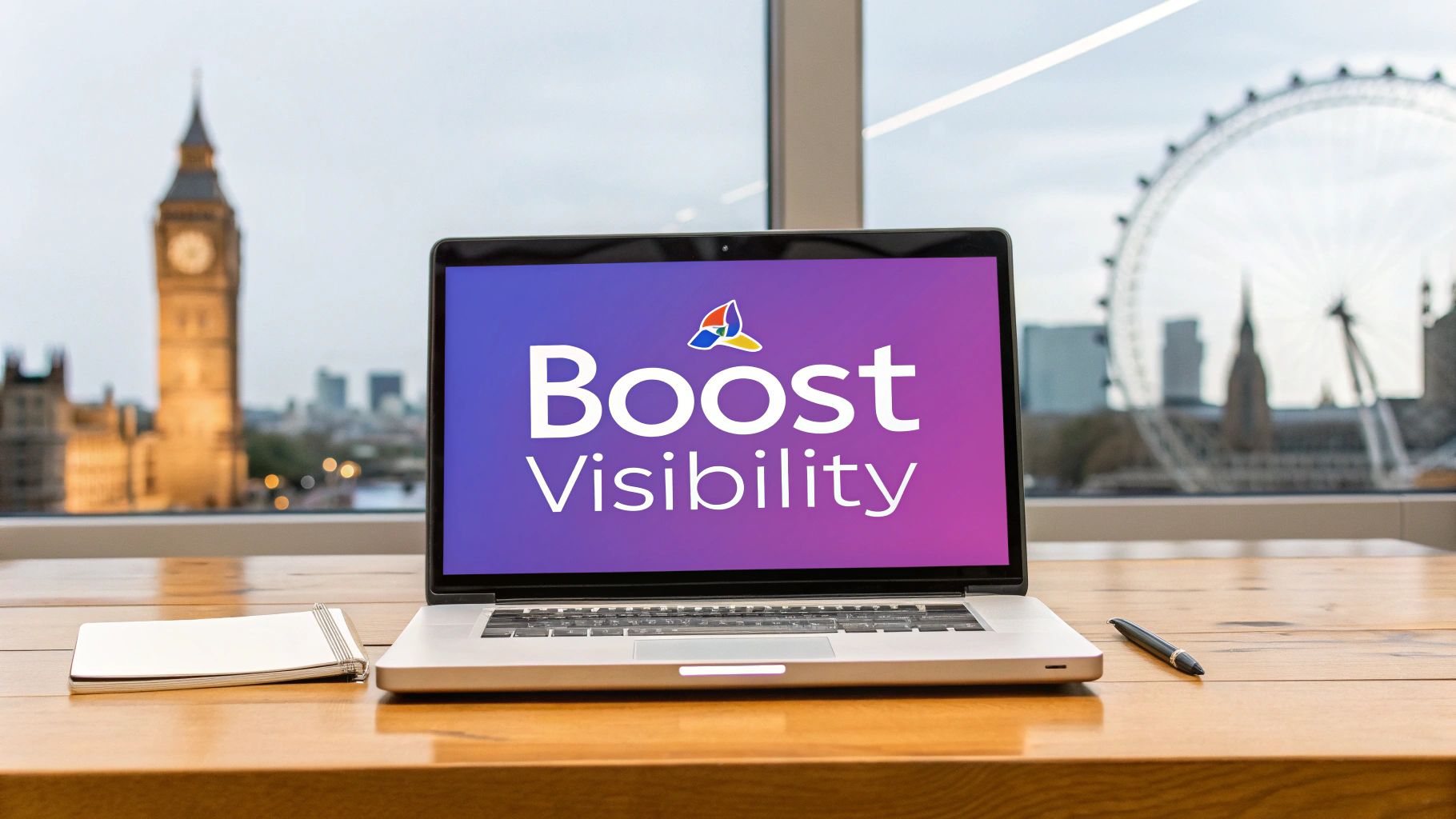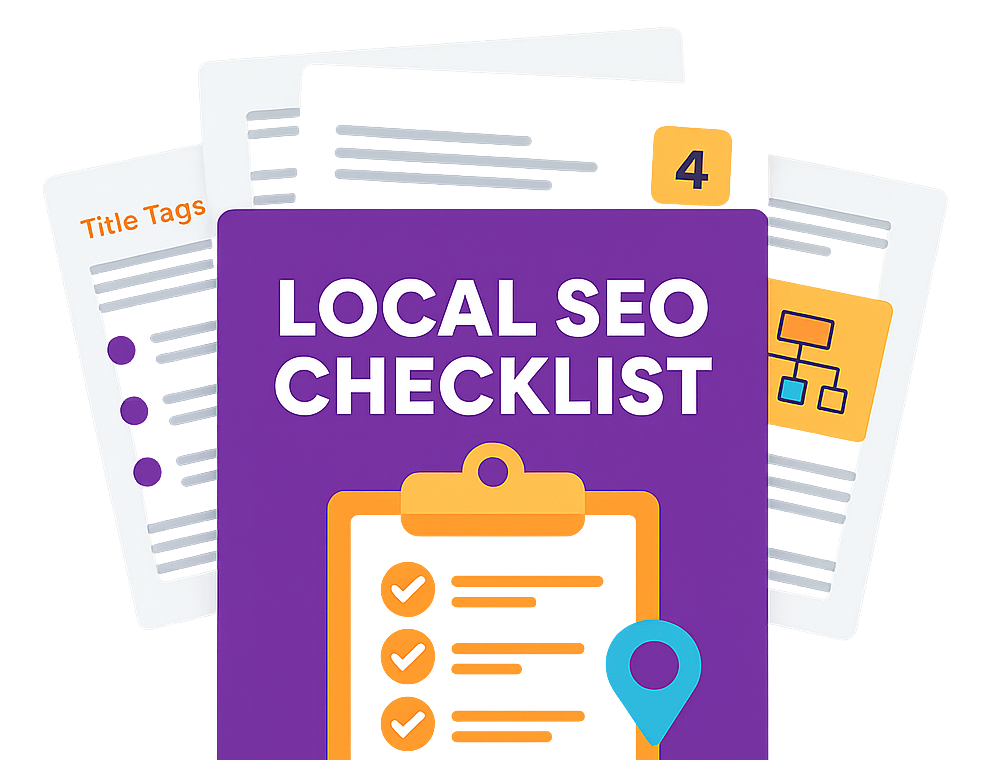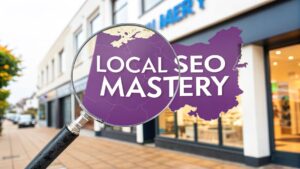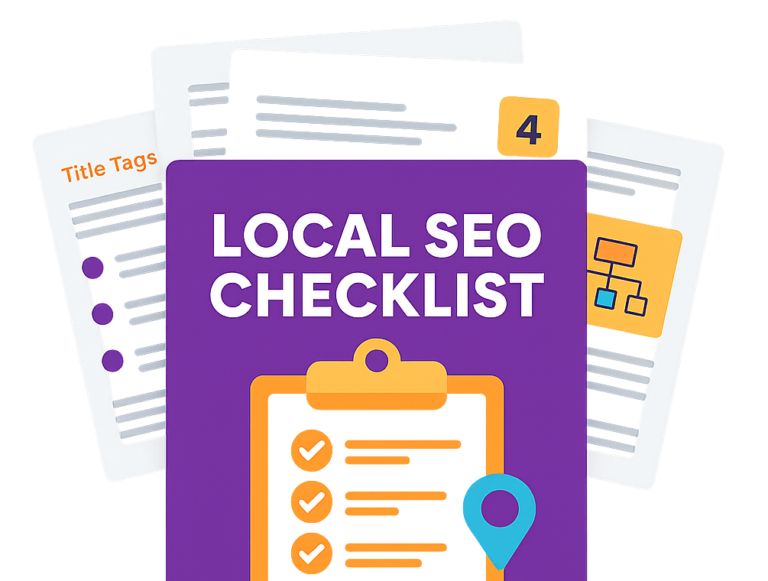Optimising your Google Business Profile is all about turning that free listing into one of your best customer acquisition tools. It's not just about filling out a few boxes; it’s about actively managing your profile to climb higher in local search and on Google Maps, which directly impacts how many local customers find and, more importantly, contact you.
Your Digital Front Door to Local UK Customers
Before we get into the nitty-gritty, let's be clear on why your Google Business Profile is probably your most valuable local marketing asset. For most UK customers, it’s the digital equivalent of your shop window—their very first interaction with your business. It's so much more than a simple directory listing; think of it as an interactive preview that shapes whether a customer chooses you or a competitor.
When someone nearby searches for a service or product you offer, the information they see on Google directly influences what they do next. A complete, well-managed profile gives them everything they need to make a snap decision, from your phone number and location on Google Maps to photos of your work and what other customers are saying about you.
The Real-World Impact of an Optimised Profile
A profile that’s kept fresh and active sends strong signals to Google that your business is credible, busy, and relevant to what people are searching for locally. This naturally boosts your visibility, pushing you ahead of competitors who've let their listings go stale.
Imagine a local café in Cambridge. A profile with tempting photos of its coffee, up-to-date opening times, and a steady stream of glowing reviews is far more likely to win the morning coffee run than a sparse profile with outdated details. It’s that simple.
The data really drives this home. On average, a typical business profile gets 81 monthly customer actions, like phone calls and requests for directions. A massive 48% of these interactions are clicks through to the website, proving just how many people take the next step after finding a business on Google. On top of that, 29% of actions are direction requests, which is a clear sign of its power to drive actual footfall.
Anatomy of Customer Actions on a Google Business Profile
To really understand the value here, it helps to break down what those "actions" actually are. This table shows where customers are interacting most, and it highlights why every part of your profile optimisation matters.
| Customer Action | Average Percentage of Monthly Interactions | Why It Matters for Your Business |
|---|---|---|
| Website Visits | 48% | These are high-intent users ready to learn more about your services or products. A direct path to your sales pages. |
| Direction Requests | 29% | This is a customer literally planning to visit your physical location. It's a lead walking through your door. |
| Phone Calls | 23% | A direct phone call is one of the hottest leads you can get, often from someone ready to book or buy. |
Each of these interactions represents a tangible opportunity. A call is a lead, a website click is a chance to convert, and a direction request is a customer on their way. Neglecting your profile is like leaving money on the table for your competitors to scoop up.
Why Every Interaction Matters
Every single one of these actions is a potential sale. A phone call is a direct lead. A website click is your chance to showcase everything you offer. A request for directions often means a customer is already on their way to you. If you're not managing your profile, you are actively handing this business over to your rivals.
Your Google Business Profile isn't just a marketing tool; it's a direct line to revenue. Every unanswered question, outdated photo, or unmanaged review is a missed opportunity to connect with a paying customer.
Ultimately, a complete and active profile builds trust before a customer even speaks to you. It shows you’re professional and engaged. When you pair this with broader strategies to boost visibility and improve brand awareness, you create a powerful combination for growth.
And to keep all these efforts on track, you'll want the right tools for the job. You might find our guide on the best local SEO tools in 2023 for UK businesses particularly helpful.
Building a Flawless Business Profile Foundation
The absolute bedrock of any successful Google Business Profile optimisation is flawlessly accurate and complete information. Think of it as the foundation of a house; if it’s weak, everything you build on top of it will be unstable. Getting these core details right from the very beginning is non-negotiable for ranking well in local search.
This process starts even before you touch the finer details of optimisation. The first steps—claiming and verifying your profile—are crucial for establishing your ownership and credibility with Google.
This quick visual shows the simple, essential path to getting started.

Following this sequence ensures you have full control before you begin the important task of optimisation.
Nailing Your NAP and Business Hours
Your Name, Address, and Phone number (NAP) are the three most critical pieces of data on your profile. They must be perfectly consistent—not just on Google, but everywhere your business is mentioned online, from Yell.com to your own website.
Even tiny inconsistencies, like using "St." on your profile but "Street" on your website, can confuse search engines and water down your local authority. It pays to be meticulous here.
- Business Name: Use your real-world trading name. It’s tempting, I know, but resist the urge to stuff keywords or locations in there (e.g., "Bare Digital SEO Cambridge"). This is a fast track to getting penalised by Google.
- Address: Make sure your map pin is dropped in the precise location. A pin that’s even slightly off can send customers to the wrong place, leading to frustration and, inevitably, a negative review.
- Business Hours: Be exact. Set your standard hours, and just as importantly, always update them for public holidays or special events. Nothing annoys a potential customer more than turning up to a closed business when Google promised it was open.
Choosing Categories to Attract the Right Customers
Selecting your business category is one of the most powerful moves you’ll make in your optimisation efforts. It directly tells Google what you do and which searches your business should appear for. It's a big deal. A staggering 84% of a profile's views come from 'discovery' searches—where someone looks for a category like "plumber near me" rather than a specific business name.
Your primary category needs to be the most accurate, specific description of your main service. If you're a café that specialises in brunch, choosing "Brunch Restaurant" is far more effective than the generic "Restaurant".
After that, you can add several secondary categories to capture your other offerings. For our brunch spot, that could mean adding "Coffee Shop" or "Cake Shop". Just don't get carried away; only add categories for services you genuinely provide.
Expert Tip: Take a look at your top local competitors. What primary category are they using? This can offer some brilliant insight into what works in your industry and location, but always prioritise what’s most accurate for your own business.
Crafting a Compelling Business Description
Your business description is your 750-character chance to tell potential customers what makes you different. While that short summary you see at the top of a profile is auto-generated by Google, you have full control over the "From the business" section.
Make the first 250 characters really count, as this is what people see before they have to click "more". Use this prime real estate to shout about your unique selling points. Don’t waste precious characters repeating information that’s already listed elsewhere, like your address or phone number. Weave in your keywords naturally, focusing on the language a real customer would use to find you.
Given Google's dominance in the UK, this attention to detail is vital. As of January 2025, Google holds about 93.24% of the UK search engine market. Since 87% of consumers use Google to find local businesses, a well-optimised profile gives you a massive competitive edge.
By methodically auditing and perfecting these foundational elements, you set the stage for higher rankings and more customer interactions. For businesses in our local area, these principles are central to our guide on 10 local SEO tips for Cambridgeshire businesses in 2025.
Bringing Your Business to Life With Visuals and Posts

In local search, a static profile is often an invisible one. While getting the basics right is crucial, it’s the ongoing activity that tells Google—and your customers—that you’re open, active, and worth paying attention to. This is where visuals and Google Posts come in, turning your listing from a simple directory entry into a vibrant digital shop window.
Think of your profile as a living, breathing part of your business. The more you feed it with fresh, relevant content, the healthier it becomes. I’ve seen time and again that businesses that consistently add high-quality photos and publish timely updates don't just look more professional; they genuinely perform better in local search.
The Power of High-Quality Photos
Photos are arguably the most powerful tool in your entire Google Business Profile toolkit. They offer instant proof of your quality and build trust before a potential customer even thinks about reading a review. The numbers back this up: Google says businesses with photos get 42% more requests for driving directions and 35% more clicks to their websites.
But just dumping a few random pictures onto your profile won't cut it. You need a bit of a strategy.
- Cover and Logo: Your logo should be your profile picture, simple as that. For your cover photo, choose a high-quality shot that captures your brand's personality—maybe it's your welcoming shop front, your team hard at work, or the finished product you’re proud of.
- Interior & Exterior: Upload clear, well-lit photos of the inside and outside of your business from a few different angles. This helps people recognise your building when they arrive and makes them feel more comfortable visiting.
- Team Photos: Putting a face to the name makes your business feel more human and approachable. A few friendly, professional shots of you and your staff can make a huge difference.
- Products & Services in Action: Show, don’t just tell. If you’re a baker, I want to see photos of your freshly baked bread. If you're a builder, show me the before-and-after shots of your latest project. Pro tip: Geo-tag these photos with your location data to give Google another strong signal about your local relevance.
Aim to add at least one new, high-quality image every week. That consistent activity is a positive signal that Google loves to see.
Expert Insight: Remember, any user can upload a photo to your profile. By proactively filling your listing with your own professional images, you stay in control of your brand’s visual story and keep the quality high.
Crafting Engaging Google Posts
Think of Google Posts as free mini-adverts that appear right on your Business Profile. They’re a fantastic way to share timely news, promote offers, or highlight what makes your business special. So many businesses completely ignore this feature, so using it consistently gives you an immediate leg up on the competition.
The content you share on your profile, much like your other online channels, has a huge impact on engagement. You can even find social media content ideas to inspire your posts and keep your profile fresh and interesting.
Types of Posts and When to Use Them
To really make this feature work for you, it's important to use the different post types for what they were designed for. Each one is built to drive a specific action from your customers.
| Post Type | Best Used For… | Example |
|---|---|---|
| Updates | Sharing general news, new blog articles, or company announcements. | "We're delighted to welcome our new stylist, Sarah, to the team! Book your next cut with her online." |
| Offers | Promoting sales, discounts, or special deals with a clear start and end date. | "Get 20% off all main courses from Monday to Thursday this month. Use code: WEEKDAY20." |
| Events | Announcing things like workshops, webinars, or in-store open days. | "Join our free homeowner's DIY workshop this Saturday at 10 am. Limited spaces available!" |
Creating a simple content calendar—even just a basic spreadsheet—is a game-changer for staying consistent. Try to post at least once a week. Always include a great image, a clear call-to-action (like "Book Now" or "Learn More"), and a link back to the right page on your website. This small bit of organisation is a cornerstone of effective Google Business Profile management.
Mastering Reviews And Customer Conversations

Social proof is a massive driver in local SEO, and your Google reviews are its most visible and persuasive form. Think about it: they're often the last thing a potential customer checks before deciding between you and a competitor down the road. Nailing this part of your Google Business Profile is less about technical tweaks and more about genuine human connection.
A solid review strategy isn't just about chasing five-star ratings. It's about cultivating a public conversation that puts your brilliant customer service on full display. This dialogue doesn't just sway potential customers; it sends powerful, positive signals to Google’s ranking algorithm, too.
Building A Strong Review Strategy
It all starts with providing a fantastic service or product. That’s a given. Happy customers are your best marketing asset. But even the most delighted customers often need a gentle nudge to share their positive experiences online.
The trick is to make leaving a review dead simple. A proactive approach to generating reviews should be a core part of your Google My Business optimisation. Don't be shy about asking! A significant 62% of customers will happily leave a review if you just ask them.
Here are a few ways to do it:
- Email Follow-Ups: A friendly thank-you email after a purchase or service, with a direct link to your review page, works wonders.
- In-Person Requests: For brick-and-mortar businesses, a simple, friendly ask at the point of sale can be incredibly effective when a customer is clearly pleased.
- Simple Instructions: Design a small business card or flyer with a QR code that takes them straight to your review page. Easy peasy.
Just remember, never offer discounts or freebies in exchange for reviews. It’s against Google’s policies and completely undermines the trust you’re trying to build. The aim is to encourage authentic, honest feedback.
The Art Of Responding To Every Review
Responding to reviews is one of the clearest signs of an active, engaged business. It shows both Google and potential customers that you care about feedback and are committed to satisfaction. Your response plan needs to cover every type of review, good and bad.
A thoughtful response to a negative review can often be more powerful than a dozen five-star ratings. It demonstrates accountability, professionalism, and a genuine desire to resolve issues, which builds immense trust with everyone who reads it.
Replying to positive reviews is your chance to reinforce a great experience and show appreciation. A simple, "Thanks, Sarah! We're so glad you enjoyed the coffee and hope to see you again soon" is infinitely better than radio silence.
Negative feedback requires a more careful touch. Always stay professional, thank them for raising the issue, and offer to take the conversation offline to sort things out. Dealing with unfair criticism is tough, but for reviews that cross the line, our guide on how to potentially remove a negative review from Google offers practical steps for when a review violates Google's policies.
Unlocking The Power Of The Q&A Feature
One of the most overlooked tools in your Google My Business optimisation toolkit is the Questions & Answers (Q&A) section. This feature lets anyone ask a question about your business—and, more importantly, anyone can answer. If you're not actively managing it, you're letting the public control your business's narrative.
The best defence is a good offence. You can, and absolutely should, seed this section with your own FAQs.
- Identify Common Questions: What are customers always asking you over the phone or by email? Think about parking, accessibility, payment methods, or specific service details.
- Seed Your Q&A Section: Log in and post these questions yourself. Then, immediately provide clear, helpful answers from your business account.
- Upvote Your Answers: Give your own answers a "thumbs up" to help them rise to the top and become the most visible response.
This simple tactic lets you get ahead of customer queries, highlight your best features, and establish your expertise. You’re in control of the information, ensuring it's accurate and helpful. Beyond Google, understanding what your customers are thinking is vital for business growth, so it’s always wise to explore effective strategies for getting customer feedback to refine your services even further.
Using Advanced Features To Gain a Competitive Edge
Once you’ve nailed the fundamentals, it’s time to explore the advanced features that help top-ranking businesses truly dominate local search. These powerful tools go beyond just displaying information, turning your Google Business Profile into an interactive platform for customer engagement and direct conversions. Proper Google My Business optimisation means using every feature at your disposal.
Moving beyond the basic setup is how you create a richer, more compelling profile that actively works to win you business. This is how you go from being just another name in a list to the obvious choice for local customers.
Building Your Digital Catalogue with Products and Services
The Products and Services tabs are two of the most valuable—and underused—features on Google Business Profile. They let you build a mini-catalogue of what you offer, complete with descriptions, prices, and images, all visible directly in Google's search results.
For service-based businesses like a local plumber or electrician, the Services section is non-negotiable.
- Group Services Logically: Don't just dump everything in one long list. Create distinct categories like "Boiler Installation," "Emergency Call-Outs," and "Routine Maintenance."
- Write Detailed Descriptions: For each service, provide a clear, concise description. Explain what the service includes and who it’s for.
- Add Pricing: Even if it’s just a ‘From £X’ or a price range, adding costs provides transparency and helps qualify your leads.
For businesses selling physical items, the Products feature is even more powerful. A clothing boutique can showcase its new season’s collection, or a bakery can display its most popular cakes. This gives potential customers a tempting preview before they even click through to your website.
Expert Tip: Think of the Products tab as your virtual shop window. Keep it updated with your best-sellers or seasonal items to reflect what's currently happening in your business. A static product list from two years ago suggests you aren't actively managing your profile.
Attracting Specific Customers with Attributes
Attributes are simple tags you can add to your profile to highlight key features that customers might be searching for. They appear as small, eye-catching icons on your profile and can be the deciding factor for many people.
Google offers a huge range of attributes, from practical information to more nuanced details about your business's atmosphere. Think of them as filters that help your ideal customer find you.
Some common and highly effective attributes include:
- Accessibility: 'Wheelchair-accessible entrance' or 'Accessible toilets'.
- Amenities: 'Free Wi-Fi', 'Outdoor seating', or 'Gender-neutral toilets'.
- Payments: 'Accepts credit cards' or 'NFC mobile payments'.
Choosing the right attributes is a simple but incredibly effective part of your Google My Business optimisation. It helps you show up in more filtered searches (e.g., "cafes with outdoor seating near me") and directly answers a potential customer’s unspoken questions.
Driving Direct Conversions with Booking and Messaging
Some of the most powerful features are those that connect you directly with customers who are ready to take action, generating leads without them ever leaving Google.
The Booking feature allows customers to schedule an appointment directly from your profile. Integrating this with your existing scheduling software creates a seamless path from discovery to conversion.
The Messaging feature enables instant communication. When you switch it on, a "Chat" button appears on your profile, letting customers send you a quick text message. A swift response time is crucial here; it delights customers and signals to Google that you are an engaged, responsive business.
Many small businesses find these advanced features drive significant results, often proving more cost-effective than larger campaigns. This is why exploring affordable SEO services for small businesses can be a strategic move to maximise your return on investment.
Your Google My Business Optimisation Questions Answered

Diving into a full Google My Business optimisation project always brings up a few practical questions. It's only natural to wonder about timelines, what to focus on first, and what to do when things just don't seem to be working.
This final section cuts through the noise to tackle the most common hurdles UK business owners face. Think of it as your troubleshooting guide, packed with straightforward advice from our real-world experience to help you get the most from your profile.
How Long Until I See Optimisation Results?
This is the million-pound question, isn't it? While some changes, like updating your business hours, show up on your profile almost instantly, the real impact on your rankings and customer actions is more of a slow burn.
You can usually expect to see some initial positive movement in local search visibility and profile interactions within four to eight weeks of a thorough optimisation. This first bump is the result of getting all those foundational elements right.
But true, lasting growth comes from consistency. The long-term benefits are driven by ongoing activities that signal to Google your business is active, relevant, and worth showing to searchers.
- Fresh Content: Regularly add geo-tagged photos and publish Google Posts every week.
- New Reviews: Consistently ask for and respond to new customer feedback.
- Profile Accuracy: Keep everything up-to-date, especially crucial details like holiday hours.
Don't forget, your progress is also heavily influenced by your local competition. If your rivals are on the ball with their profiles, consistent effort is what will eventually set you apart.
What Is The Single Most Important Ranking Factor?
If we had to boil it all down to one thing, it would be relevance. And for Google, relevance is overwhelmingly determined by your business categories.
Choosing the most accurate and specific primary category for what you really do is absolutely critical. For example, a specialist garage in Chelsea should pick "MOT Centre" or "Car Repair and Maintenance"—not the vague "Car Services." That precision directly tells Google which searches you are a good match for.
While categories are king, proximity and prominence are right behind. Proximity is simply the searcher's physical distance from you. Prominence is Google's measure of how well-known your business is, which is heavily influenced by your review count, average rating, and how complete your profile is.
To get to the top of Google Maps, you need to nail all three. But it all starts with picking the right categories to make sure you're even in the running for the searches that matter.
Why Is My Competitor Ranking Higher With A Worse Profile?
This one is a classic—and incredibly frustrating. You've spent hours meticulously optimising every single section, yet a competitor with a half-empty profile is sitting above you in the search results. What gives?
The answer almost always lies in "off-page" factors that you can't see on their Google Business Profile itself.
- Local Citations: They probably have more mentions (with consistent name, address, and phone data) on other reputable UK online directories like Yell, Thomson Local, or industry-specific sites.
- Website Strength: Their own website might just be better optimised for local SEO, carrying more authority and backlinks.
- Older Profile: Sometimes, an older, more established profile can simply carry more weight in Google's eyes.
Instead of tearing your hair out, focus on what you can control. Double down on your own game. Make sure every last part of your profile is 100% complete. Kick off a proactive campaign to earn more high-quality, recent reviews. And commit to uploading new, geo-tagged photos and creating Google Posts every single week. Consistent, high-quality activity is the surest way to overtake them in the long run.
Does Responding To Reviews Really Help My Local SEO?
Yes, absolutely. Responding to reviews is a non-negotiable part of Google My Business optimisation, and it helps your local SEO in two major ways.
First, it’s a direct and powerful signal to Google. When you take the time to reply, you're showing the algorithm that you’re an active, engaged business owner who cares about customer feedback. Google sees this as a clear sign of a trustworthy, well-managed business—a definite positive ranking signal.
Second, and maybe even more importantly, your responses have a huge influence on potential customers. When people see you providing thoughtful, professional replies to both glowing praise and constructive criticism, it builds massive trust. It shows you're accountable. You can also naturally weave in keywords in your responses (e.g., "We're so glad you enjoyed our signature Sunday roast here in Manchester!"), which subtly reinforces your local relevance.
Ready to take your local search presence to the next level? At Bare Digital, we provide a free, no-obligation SEO Health Check to show you exactly where your opportunities lie. We create a bespoke activity plan so you know precisely how we'll boost your rankings and drive more customers to your door. Get your custom proposal today at https://www.bare-digital.com.








